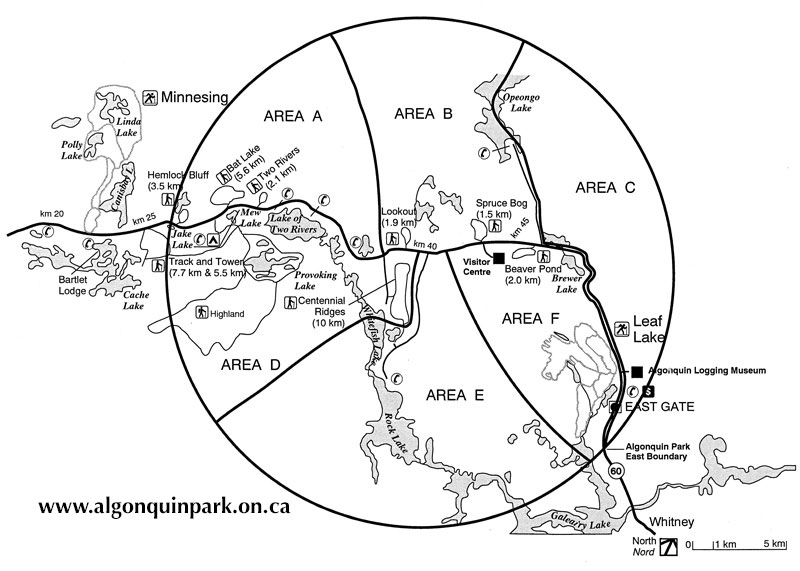Events Calendar
Current Weather
January 3, 2015
Christmas Bird Count Results 2015
The 42nd Algonquin Park Christmas Bird Count (CBC) was held on Saturday, January 2, 2016. Weather conditions were good for observing, despite a little very light freezing drizzle around dawn and infrequent very light drizzle and light wind gusts during the day. Temperatures ranged from -4°C to 0°C. The Madawaska River was completely open and Lake of Two Rivers was nearly all open (for the first time on a count), but no waterfowl were observed. A maximum of about 25 cm of snow on the ground made walking fairly easy.
Christmas Bird Count Circle in Algonquin Park
Bird count volunteers follow specified routes through a designated 24 kilometre diameter circle (shown below) and count every bird they see or hear with a 24 hour period. This provides an early winter bird census for Algonquin Park and combines with data from other counts in Canada, the United States, and many other countries. In Algonquin Park, the 24 kilometre circle is centred on the intersection of the Rock Lake Road and Highway 60.
Overall Results
- Total Observers 110 (beating the previous high of 87)
- Total Species 31 (average is 27)
- Total Individuals 6,258 (average is 4,581)
- New Species for the Count - none
Noteworthy Species
- Red-tailed Hawk 1 (8th time on count)
- Golden Eagle 1 (7th time on count)
- Belted Kingfisher 1 (3rd time on count)
Noteworthy Total Individuals
- Black-capped Chickadee 2,135 (previous high was 2,108)
- Red-breasted Nuthatch 947 (highest is 1,384)
Finches
- Pine Grosbeak 20
- Purple Finch 180
- Red Crossbill 22
- White-winged Crossbill 21
- Common Redpoll 436
- Pine Siskin 1,205
- American Goldfinch 37
- Evening Grosbeak 129
Species Observed on the 2015 Algonquin Park CBC
- Bald Eagle 1
- Golden Eagle 1
- Red-tailed Hawk 1
- Ruffed Grouse 45
- Spruce Grouse 1
- Barred Owl 2
- Belted Kingfisher 1
- Downy Woodpecker 76
- Hairy Woodpecker 61
- Black-backed Woodpecker 13
- Pileated Woodpecker 24
- Northern Shrike 1
- Gray Jay 49
- Blue Jay 357
- Common Raven 104
- Black-capped Chickadee 2,135
- Boreal Chickadee 9
- Red-breasted Nuthatch 947
- White-breasted Nuthatch 38
- Brown Creeper 25
- Golden-crowned Kinglet 183
- Dark-eyed Junco 1
- Snow Bunting 3
- Pine Grosbeak 20
- Purple Finch 180
- Red Crossbill 22
- White-winged Crossbill 21
- Common Redpoll 436
- Pine Siskin 1,205
- American Goldfinch 37
- Evening Grosbeak 129
- Woodpecker sp. 8
- Finch sp. 122
- Total Number of Species 31
- Total Number of Individuals 6,258
- Number of Observers 110
- Total Party Hours 224
- Birds Per Party Hour 27.9
Thanks to all the participants and those who helped organize and undertake
the count this year.
Ron Tozer
Algonquin Park CBC Compiler
Birders reporting records through eBird are encouraged to share their lists with the Algonquin Park Bird Records account (APPbirds).
Please send us any bird sightings you've had in the park, even of common birds, as they assist us in documenting Algonquin Park's bird life.
What is the Christmas Bird Count?
The Christmas Bird Count (CBC) is a long-standing program of the National Audubon Society, with over 100 years of citizen science involvement. It is an early-winter bird census, where thousands of volunteers across the US, Canada and many countries in the Western Hemisphere, go out over a 24 hour period to count birds.
How is the Christmas Bird Count conducted?
Count volunteers follow specified routes through a designated 24 kilometre diameter circle, counting every bird they see or hear all day. It’s not just a species tally—all birds are counted all day, giving an indication of the total number of birds in the circle that day. If observers live within a CBC circle, they may arrange in advance to count the birds at their feeders and submit those data to their compiler. All individual CBC’s are conducted in the period from December 14 to January 5 (inclusive dates) each season, and each count is conducted in one calendar day.
Why was the Christmas Bird Count started?
The first CBC was done on Christmas Day of 1900 as an alternative activity to an event called the “side hunt” where people chose sides, then went out and shot as many birds as they could. The group that came in with the largest number of dead birds won the event. Frank Chapman, a famed ornithologist at the American Museum of Natural History and the editor of Bird-Lore (which became the publication of the National Association of Audubon Societies when that organization formed in 1905) recognized that declining bird populations could not withstand wanton over-hunting, and proposed to count birds on Christmas Day rather than shoot them.
Is the Christmas Bird Count useful?
Absolutely. The data collected by observers over the past century allow researchers, conservation biologists, and interested individuals to study the long-term health and status of bird populations across North America.
Related Information
Reserve your developed or backcountry campsite for your next visit.
Share your passion for Algonquin Park by becoming a member or donor.
Special regulations for Algonquin's special fishery.










